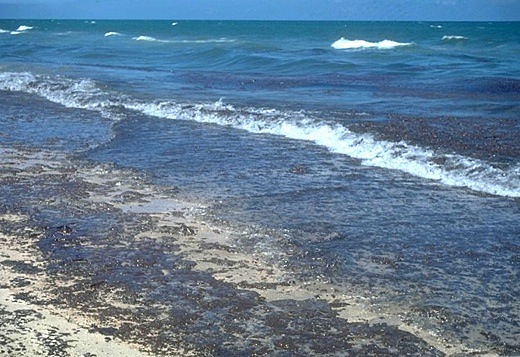 Image above: Crude oil contaminated shoreline along the Gulf of Mexico. From (http://dotearth.blogs.nytimes.com/tag/gulf-spill)
Image above: Crude oil contaminated shoreline along the Gulf of Mexico. From (http://dotearth.blogs.nytimes.com/tag/gulf-spill)
By Dan Froomkin on 6 May 2010 in the Huffington Post - (http://www.huffingtonpost.com/2010/05/06/gulf-oil-spill-a-symbol-o_n_566196.html)
The leading edge of a vast oil slick started to come ashore in Louisiana on Thursday night, a shroud of devastation falling on America's coastline even as the blown-out BP oil well that produced it continues to belch millions of gallons of thick crude into the Gulf of Mexico for a third straight week. At moments like this, it's hard to see any silver lining here at all. But it's possible there is one. Many environmentalists say that the wrenching and omnipresent images of filth and death are at last providing Americans with visible, visceral and possibly mobilizing evidence of the effects that fossil fuels are having on our environment every day. Rick Steiner is horrified at the damage. A University of Alaska marine specialist, he's watched cleanup efforts ever since the Exxon Valdez spill in 1989, and has learned some bitter lessons. "Government and industry will habitually understate the volume of the spill and the impact, and they will overstate the effectiveness of the cleanup and their response," he said. "There's never been an effective response -- ever -- where more than 10 or 20 percent of the oil is ever recovered from the water. Once the oil is in the water, the damage is done." And most of the damage remains invisible deep below the surface, including the wide-scale destruction of essential plankton in the area and the wiping out of an entire generation of fish larvae. "This is real toxic stuff," Steiner said. But the damage that is visible -- the vast and foul oil slick, the dolphins swimming through sludge, the birds coated in oil, the dead fish and sharks and turtles -- is enough to thoroughly disgust anyone paying attention. And that, Steiner said, makes it a "teachable moment" that "will hopefully serve as a wake-up call that we need to turn to sustainable energy." After all, that carbon we're seeing poison the Gulf was headed into the planetary ecosystem anyway, through tailpipe emissions. "That's part of the irony of all this, is it just took a shortcut," Steiner said. "This carbon took a shortcut into the environment from what it normally does, and it's obvious to people what the problem is here." A much smaller oil spill in Santa Barbara 40 years ago helped mobilize the Earth Day movement, which in turn led to most of the major environmental legislation of the 20th century. The Exxon Valdez disaster, 20 years later, led to tougher (but evidently not tough enough) rules about oil spills. And now Steiner and fellow environmentalists think this spill provides an opportunity not just to revisit offshore oil drilling, but the whole carbon dynamic. "This just reminds us, in a powerful way, how dirty the energy we rely on is," said environmental writer Bill McKibben. "If anything good is going to come out of this, it'll be because it focuses our attention - but more palpably, focuses the president's attention - on questions of dirty energy." See also: Ea O Ka Aina: An American Chernobyl 5/6/10 .
No comments :
Post a Comment